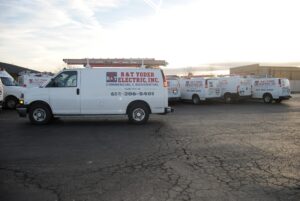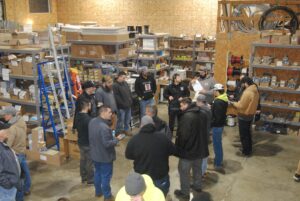
Are you looking to trace electrical wires in your home or business but not sure where to start? Look no further than Yoder Electric, a trusted electrical company founded by Rod and Tina Yoder in 2004. With years of experience and a team of over 50 skilled employees, Yoder Electric has the expertise and professionalism to handle any electrical job. Whether it’s for your home or business, you can rely on Yoder Electric to get the job done right. Let our certified electricians guide you through the process of tracing electrical wires with ease and efficiency. Trust Yoder Electric for all your electrical needs!
Have you ever needed to trace electrical wires in your home or workplace but didn’t know where to start? Don’t worry, with the right tools and techniques, you can easily identify and trace electrical wires safely and accurately. Follow along as we guide you through the process step by step. Let’s get started!
Understanding Electrical Wiring Basics
Before you begin tracing electrical wires, it’s important to have a basic understanding of how electrical wiring works. Electrical wires are used to transmit electrical power from the source to various appliances, lighting fixtures, and outlets throughout a building. There are typically three main types of wires:
- Hot Wires: These wires carry electrical current from the power source to the device.
- Neutral Wires: These wires return the current back to the power source.
- Ground Wires: These wires provide a safe path for excess electrical current to flow in case of a fault.
Why is it important to know the basics of electrical wiring?
Understanding the basics of electrical wiring will help you identify the different types of wires and their roles in the electrical system. By knowing these fundamentals, you’ll be better equipped to trace wires accurately and avoid any potential safety hazards.
Tools You’ll Need for Tracing Electrical Wires
Now that you have a grasp of the basics, it’s time to gather the necessary tools for tracing electrical wires. Here are some essential tools you’ll need to successfully trace electrical wires:
| Tool | Description |
|---|---|
| Voltage Tester | Used to determine if a wire is live or not. |
| Wire Tracer Kit | Helps you identify wires inside walls. |
| Multimeter | Measures electrical values such as voltage. |
| Circuit Breaker Finder | Locates specific circuit breakers. |
Why are these tools essential for tracing electrical wires?
Having the right tools is crucial for tracing electrical wires safely and accurately. Each tool serves a specific purpose in the tracing process, helping you identify and track wires without causing damage to the electrical system.
Steps to Trace Electrical Wires
With the necessary tools in hand, let’s walk through the step-by-step process of tracing electrical wires in your home or workplace. Follow these guidelines carefully to ensure a successful wire tracing operation:
Step 1: Turn Off Power
Before you begin tracing electrical wires, make sure to turn off the power to the circuit you’ll be working on. This step is crucial for your safety and will prevent any accidental electrical shocks while tracing the wires.
Step 2: Identify the Wire
Use a voltage tester to determine if the wire you’re tracing is live. Once you’ve confirmed that the wire is not carrying electrical current, you can proceed to trace it without any risks.
Step 3: Start Tracing
Begin tracing the wire by following its path from the source (such as a circuit breaker) to the destination (an outlet or appliance). Use a wire tracer kit or multimeter to help you locate and identify the wire accurately.
Step 4: Label the Wire
As you trace the wire, consider labeling it with tape or markers to keep track of its path. This will be helpful in the future if you need to work on the electrical system again or make changes.
Step 5: Document and Plan
Take notes or create a diagram of the wire’s path to document your tracing process. Planning ahead will help you troubleshoot any electrical issues in the future and make modifications to the system if needed.
Step 6: Test the Wire
Once you’ve traced the wire and completed your documentation, test the wire to ensure it’s functioning correctly. Use a multimeter to measure voltage or continuity to verify that the wire is connected properly.
Step 7: Restore Power
After you’ve successfully traced and tested the wire, you can restore power to the circuit. Double-check your work to make sure all connections are secure and that the electrical system is functioning as intended.
Common Challenges in Tracing Electrical Wires
While tracing electrical wires can be a straightforward process, there are some common challenges you may encounter along the way. Here are a few issues and tips on how to overcome them:
Identifying Multiple Wires
If you’re working in a complex electrical system with multiple wires, it can be challenging to trace one specific wire. Using a wire tracer kit with adjustable sensitivity can help you isolate the wire you’re looking for.
Hidden Wires
In some cases, wires may be hidden behind walls, ceilings, or insulation, making them difficult to trace visually. Consider using a circuit breaker finder or wire locator tool to help you pinpoint the wire’s location without needing direct access.
Inconsistent Wiring
Older buildings or DIY electrical work may have inconsistent wiring that doesn’t follow standard color-coding conventions. In these situations, it’s essential to test and verify each wire’s function before tracing it to avoid any confusion or mistakes.
Safety Precautions
When tracing electrical wires, always prioritize safety by wearing insulated gloves, goggles, and other protective gear. Ensure that the power is turned off before touching any wires and proceed with caution to prevent electrical accidents.
Tracing electrical wires may seem like a daunting task, but with the right tools and knowledge, you can quickly and safely identify wires in your home or workplace. By following the steps outlined in this guide and being prepared for common challenges, you’ll become more confident in navigating the electrical system and troubleshooting any issues that arise. Remember to prioritize safety at all times and consult a professional electrician if you encounter any problems beyond your expertise. Happy tracing!







